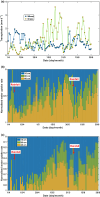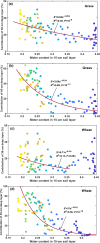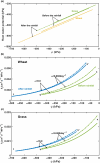Field plants strategically regulate water uptake from different soil depths by spatiotemporally adjusting their radial root hydraulic conductivity
- PMID: 40104889
- PMCID: PMC12177284
- DOI: 10.1111/nph.70013
Field plants strategically regulate water uptake from different soil depths by spatiotemporally adjusting their radial root hydraulic conductivity
Abstract
Plants modify their root hydraulics to maintain water status and strategically use soil water, but how they achieve this in the field conditions remains elusive. We developed a method to measure and calculate daily root water uptake, root water potential, and radial root water permeability at different depths in a wheat (Triticum aestivum L.) field and a permanent grassland dominated by ryegrass (Lolium perenne L.). During the drying processes, both plant systems reduced the radial water permeability of their shallow roots to limit topsoil water uptake, while increasing the radial water permeability of their roots in the subsoil to enhance water extraction. Conversely, after the topsoil was rewetted, both plant systems increased the radial water permeability of their shallow roots to enhance water extraction, while reducing the radial water permeability of their roots in the subsoil to limit water uptake. Root water uptake in the subsoil was more influenced by the topsoil water than by the subsoil water. The topsoil water serves both as a resource and a signal, coordinating optimal water uptake from different soil depths. These findings have important implications for understanding how plants cope with periodic water stress in the field and for screening drought-tolerant crop varieties.
Keywords: in situ measurements; permanent grass; radial root water permeability; root water potential; root water uptake; winter wheat.
© 2025 The Author(s). New Phytologist © 2025 New Phytologist Foundation.
Conflict of interest statement
None declared.
Figures







Similar articles
-
Effects of atmospheric CO2 concentration on transpiration and leaf elongation responses to drought in Triticum aestivum, Lolium perenne and Festuca arundinacea.Ann Bot. 2024 Nov 13;134(5):787-802. doi: 10.1093/aob/mcae114. Ann Bot. 2024. PMID: 39086357 Free PMC article.
-
Three-dimensional image analysis specifies the root distribution for drought avoidance in the early growth stage of rice.Ann Bot. 2024 Oct 30;134(4):593-602. doi: 10.1093/aob/mcae101. Ann Bot. 2024. PMID: 38908006 Free PMC article.
-
Data on transgenerational memory effects of photosynthetic efficiency of twelve wheat varieties under elevated carbon dioxide concentration and reduced soil water availability.Data Brief. 2025 Apr 9;60:111545. doi: 10.1016/j.dib.2025.111545. eCollection 2025 Jun. Data Brief. 2025. PMID: 40534714 Free PMC article.
-
Assessing the comparative effects of interventions in COPD: a tutorial on network meta-analysis for clinicians.Respir Res. 2024 Dec 21;25(1):438. doi: 10.1186/s12931-024-03056-x. Respir Res. 2024. PMID: 39709425 Free PMC article. Review.
-
Not so hidden anymore: Advances and challenges in understanding root growth under water deficits.Plant Cell. 2024 May 1;36(5):1377-1409. doi: 10.1093/plcell/koae055. Plant Cell. 2024. PMID: 38382086 Free PMC article. Review.
References
-
- Abdalla M, Carminati A, Cai G, Javaux M, Ahmed MA. 2021. Stomatal closure of tomato under drought is driven by an increase in soil–root hydraulic resistance. Plant, Cell & Environment 44: 425–431. - PubMed
-
- Bachofen C, Tumber‐Dávila SJ, Mackay DS, McDowell NG, Carminati A, Klein T, Stocker BD, Mencuccini M, Grossiord C. 2024. Tree water uptake patterns across the globe. New Phytologist 242: 1891–1910. - PubMed
MeSH terms
Substances
Grants and funding
LinkOut - more resources
Full Text Sources

